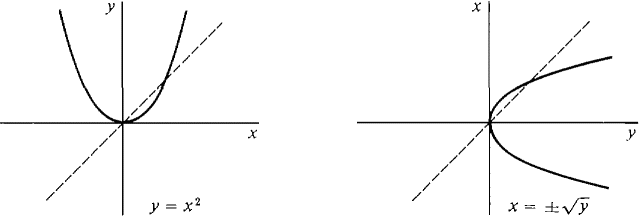| The ebook Elementary Calculus is based on material originally written by H.J. Keisler. For more information please read the copyright pages. |

|

Home  Trigonometric Functions Trigonometric Functions  Inverse Trigonometric Functions Inverse Trigonometric Functions  Inverse Trigonometric Functions Inverse Trigonometric Functions |
|






|
|
Inverse Trigonometric Functions
Inverse functions were studied in Section 2.4. We now take up the topic again and apply it to trigonometric functions. A binary relation on the real numbers is any set of ordered pairs of real numbers. Thus a real function f of one variable is a binary relation such that for each x, either there is exactly one y with (a\ y) in f or there is no y with (x, y) in f. (Other important relations are x < y, x ≤ y, x ≠ y, x = y.) DEFINITION Let S be a binary relation on the real numbers. The inverse relation of S is the set T of all ordered pairs (y, x) such that (x, y) is in S. If S and T are both functions they are called inverse functions of each other. The inverse of a function f may or may not be a function. For example, the inverse of y = x2 is the relation x = ±√y, which is not a function (Figure 7.3.1). But the inverse of y = x2, x ≥ 0, is the function x = √y (Figure 7.3.2).
Figure 7.3.1
Figure 7.3.2 Geometrically, the graph of the inverse relation of y = f(x) can be obtained by flipping the graph of y = f(x) about the diagonal line y = x (the dotted line in Figures 7.3.1 and 7.3.2). This flipping interchanges the x- and y-axes. This is because f(x) = y means (x, y) is in f, and g(y) = x means (y, x) is in g. It follows that: If f and g are inverse functions then the range of f is the domain of g and vice versa. Which functions have inverse functions? We can answer this question with a definition and a simple theorem. DEFINITION A real function f with domain X is said to be one-to-one if f never takes the same value twice, that is, for all x1 ≠ x2 in X we have f(x1) ≠ f(x2).
|
|
Home  Trigonometric Functions Trigonometric Functions  Inverse Trigonometric Functions Inverse Trigonometric Functions  Inverse Trigonometric Functions Inverse Trigonometric Functions |
|
Last Update: 2006-11-25



